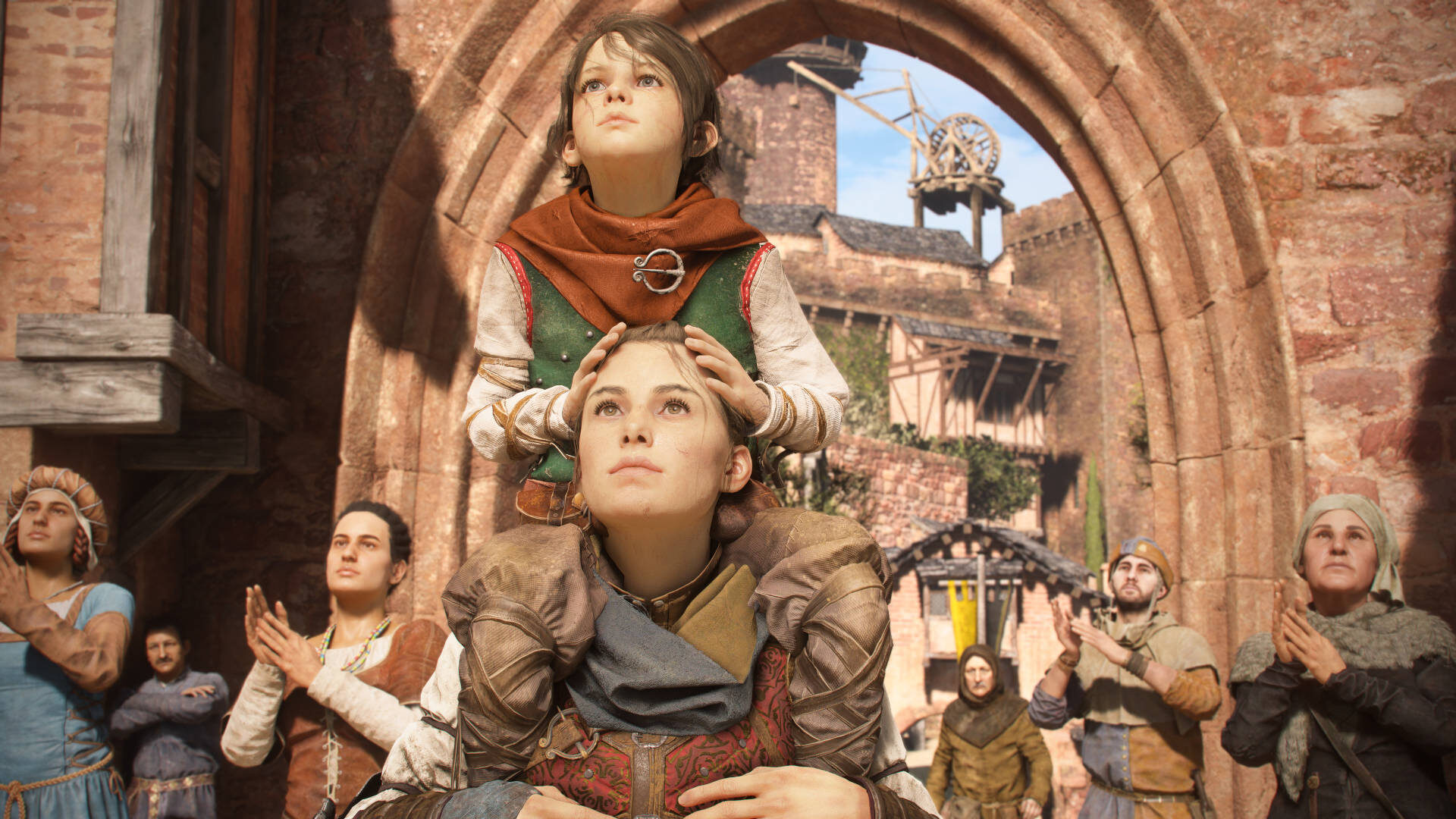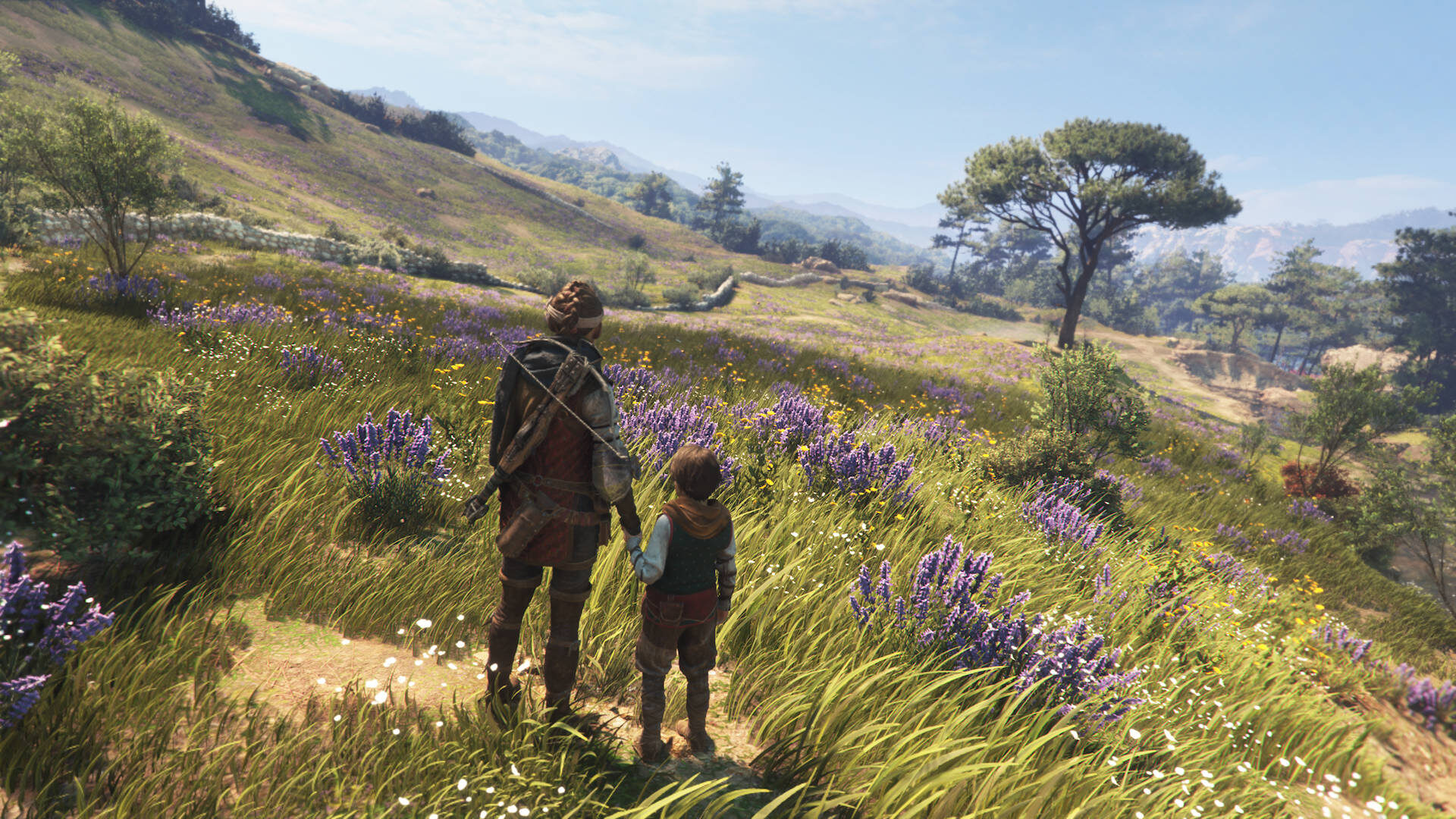Warning: It is impossible to talk about A Plague Tale: Requiem without delving into major spoilers for its predecessor, A Plague Tale: Innocence, as well as minor spoilers for the game itself. While I’ll be careful about spoilers when talking about Requiem, if you’ve yet to play Innocence but have interest in doing so, don’t read any further.
One of the games I’ve been most looking forward to this year is the second chapter of the story of two family members traveling across harsh European lands on a journey that will push both to their limits. Their goals are twofold: first, to stop the coming apocalypse, and second, to find out the truth about the boy, who while being the younger of the duo, grows stronger in power and determination by the day. To succeed, many will need to fall by the pair’s hands, and challenges of mystical origin both beautiful and horrific must be overcome.

Okay, by this point, I’m sure you get the joke: A Plague Tale: Requiem and God of War Ragnarök have at least a few similarities. What’s surprising, though, is that both games are comparable (to an extent) not just in themes, but also in anticipation and potential. It’s not unexpected to see another stellar single-player experience come from a Sony studio, but A Plague Tale: Innocence was a real shock when it hit in 2018. Its creator, Asobo Studio, was previously known for licensed Pixar titles and the solidly average ReCore, so to have such a compelling and touching adventure come from the French studio caught many of us by surprise.
Of course, the downside to having such a sleeper hit on your hands is what to do as a follow-up. How do you craft a sequel that can justify its existence while also ramping up the drama and narrative while also now having to meet expectations where there previously were none?
You make A Plague Tale: Requiem, that’s how.
At the end of Innocence, siblings Amicia and Hugo de Rune, their mother Béatrice, and apprentice alchemist Lucas had set off to try to find peace. Thanks to both the French Inquisition and the Black Plague, Amicia and Hugo had fought long and hard to get to that point—the older sister having hands now stained in the blood of those she killed to protect Hugo, and the younger brother fighting to keep at bay the Macula, a curse that connects him to the diseased rats. As Requiem kicks off, it’s been six months since the end of the previous game. While life initially seems normal, the effects of what happened to the siblings still linger just under the surface, much like the rat hordes that Hugo now holds some control over. Béatrice and Lucas, in an attempt to help find a cure for the child, turn to the Order, a secret group that has long studied the Macula. Unfortunately, the Order’s solution to Hugo’s growing illness (and threat) sits well with neither he nor Amicia, and their determination to instead chase a solution born from Hugo’s dreams sets off a chain of events that threatens mankind.

Much like the original game, A Plague Tale: Requiem switches between different play styles depending on the current events at that part of the story. Sometimes, you guide Amicia around the world in simple exploration, taking in the captivating sights and sounds of an increased variety of locations across 14th century France. At other times, you might be solving puzzles to open up a path, carefully making your way through an endless sea of rats by keeping them away with fire or other light sources, or trying to sneak around human enemies—and engaging them in combat when stealth is no longer an option. While the original game constantly swapped between those scenarios, Requiem does a better job of mixing things up in order to keep the game always feeling fresh. There are certainly times here when the gameplay can get overwhelming or even a little frustrating, but it almost always isn’t long before you’ll be off in a different location doing something new.
In my review of Innocence, I came away shocked that a game heavily based on two ideas that I typically hate—stealth and escort missions—could capture my heart. Here, sneaking around was something I not only expected, but even looked forward to. On the other side, Amicia tends not to spend as much time with Hugo as she did before, so when they are together, it feels more special. Instead, she’s often accompanied by a variety of other, more adept NPC characters, who add their own small twists to gameplay.
Speaking of, Amicia is more—and also a little less—capable this time around. Interestingly, a few abilities she had before, such as putting enemies to sleep or knocking off their helmets, are now gone. In their place, our heroine can now throw jars with alchemical properties, use tar to light larger areas on fire, and even whip out a crossbow to dispatch foes or attach ropes to objects. As opposed to Innocence, where more of her abilities seemed tailored for taking out human opponents, Amicia’s roster of options here feels better suited to dealing with man and beast alike. Outside of a few moments where I seemed locked into a particular method of proceeding, I almost always felt like I had more say over how to handle a situation, be it sneakily taking out guards or traversing a rat-infested field—even more so whenever Hugo comes into the picture. With his deepening (and troublesome) connection to the hordes, he can learn from his furry frenemies where nearby enemies are, or sic the creatures on any poor soul who has strayed from the safety of a light source.
Of course, how comfortable you feel about asking a child to send plague rats off to eat a fellow human is something you’ll have to decide for yourself. It also leads us to, by far, the heart and soul of A Plague Tale: Requiem.

To get there, though, we have to talk for a moment about another title: 2013’s Tomb Raider. After some initial mixed feelings, I came to really like both the game and its reimagining of protagonist Lara Croft. However, there’s a moment during the story that still doesn’t sit right with me to this day. After Lara gets her first kill with a gun, we see her react negatively to what she’s just done, and it hints at a video game character having to deal with the ramifications of what we, as the player, continually ask them to do. And yet, minutes later, we’re able to gun down a whole squad of people, and Lara never gives it another thought.
All these years later, A Plague Tale: Requiem is finally the payoff to that scene that I’ve been waiting for. It is the answer to the question, “what if there were actually consequences for all of the people this character is killing?” It doesn’t take long for us to see that both Amicia and Hugo are not okay, even early on. They survived the events of the first game physically, but clearly not mentally and emotionally. Requiem invites us to watch as both characters continually spiral out of control while also constantly making their situations worse due to their actions, and it makes us be a willing participant in their distress. I’m honestly not sure I can remember the last game I personally played that did such a brilliant job of showing us the repercussions of someone’s actions, and while what transpired across my 18 hours of playtime was uncomfortable, and distressing, and heartbreaking, it was also utterly engrossing.
And, to clarify, I know that this isn’t the only video game to tackle such topics—but I was both caught by surprise that it was approached here, and impressed with how well it was handled. It could have been easy for Requiem to turn into something that was exploitative, or cheesy, or overly preachy, and yet it never does.
Stung by the Stinger
I wasn’t sure that I wanted to put this directly into my review for A Plague Tale: Requiem, as I don’t think it in any way negates everything the game did up until the final credits rolled.
However, after they roll, Asobo Studio gives us a post-credits stinger—which can’t have been longer than 10 seconds, if it was even that—that genuinely made me angry.
I know I’m being annoying by calling something out so strongly that I refuse to explain further, but I cannot express how absolutely awful I found that quick video clip. Deep in my heart, I had the feeling that something like that scene might happen, but I refused to believe that the team would actually go there. Yet, they did.
Look, I know why they did. And honestly, I’m rather they go that route than certain other options. But I still completely hate it and what it means—especially when it serves to cap off something that felt so special otherwise.
The events of A Plague Tale: Requiem even left me feeling uneasy with my own mental and emotional reactions to what took place. About a third of the way through the game, there’s a scene when Amicia starts gleefully slaughtering a group of soldiers, and when she gets in trouble, Hugo steps in to finish the job. As all of this is happening, their mother and Lucas are pleading with them to stop—but they don’t listen. They kill, and they savor the killing. And when it’s over, it’s clear that something inside both of them is now broken more than it was before. What made that scene so much more emotional, though, was my part in it. As they went on their bloody rampage, I not only cheered them on, but helped them do so through my controller. And then, when the fighting was over, I felt guilt for helping them go through that. It’s like taking joy in watching your child finally beat up that bully that’s terrorized them for so long, only to then have to deal with the fact that your child might now be more traumatized than they were before. They did what they had to do, but in doing so, gave up a piece of their innocence in exchange. Those actions can never be undone, and what was lost can never be regained.
In that, A Plague Tale: Requiem is a hard game to play. Having now finished it, I don’t know that I have it inside of me to go through it again. And, it’s a game that I cannot recommend to anyone who has yet to play A Plague Tale: Innocence. If you don’t have that connection with what these characters have been through before, then it’ll be hard for you to appreciate who they are and what they go through here. Without that prior knowledge, Amicia will come off like an obnoxious, overbearing psychopath, and Hugo an annoying demon child who someone should maybe think about throwing into a pit of fire before he dooms us all. As well, Requiem is not its predecessor, which was a more down-to-earth, sorta based on real life events story that was smaller in score and ambition. This is a bigger, louder, and more fantastical adventure that will undoubtedly feel too brash and bombastic if you’ve not played the first game, and may still be just a little too much even if you have.

Even in all of that, and everything else it is and isn’t, I cannot help but come away seeing A Plague Tale: Requiem as an exceptional gaming experience. It started with me caught off guard by how happy I was to see Amicia, Hugo, and Lucas again, and ended with me in tears having witnessed what fate had in store for them. Instead of just giving us more of the same, the development team shot for something greater, crafting a tale that could easily have gone off the rails or felt like a cheapening of everything that Innocence gave us yet never does. This is an emotional, gripping, and harrowing story about having to pay the price for one’s actions, and the result was a video game that offered a level of emotional connection unlike anything I’ve played in years.
|
★★★★★
Siblings Amicia and Hugo went to hell and back in A Plague Tale: Innocence in their quest to survive an inquisition, endless hordes of rats, and the humans that looked to take advantage of the young boy’s curse. And now, in A Plague Tale: Requiem, they must pay the devil his due. This is the tale of the duo wanting to control their own fate as the fragile peace they had found falls apart, and the harsh lesson that their choices have consequences. As a game, Requiem is a bigger, better, and more ambitious adventure over its predecessor, but as a story, and a look into the lives of the characters that inhabit it, it’s so much more. |
Developer Asobo Studio Publisher Focus Entertainment ESRB M - Mature Release Date 10.18.2022 |
| A Plague Tale: Requiem is available on Xbox Series X/S, PlayStation 5, PC. Primary version played was for Xbox Series X. Product was provided by Focus Entertainment for the benefit of this coverage. EGM reviews on a scale of one to five stars. | |

Mollie got her start in games media via the crazy world of gaming fanzines, and now works at EGM with the goal of covering all of the weird Japanese and niche releases that nobody else on staff cares about. She’s active in the gaming community on a personal level, and an outspoken voice on topics such as equality in gaming, consumer rights, and good UI. Check her out on Bluesky and Mastodon.